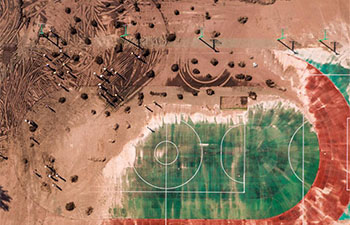SHANGHAI, July 25 (Xinhua) -- At first glance, the automated external defibrillators (AED) in glass cases at stations on Shanghai Metro line 9 look like fire-fighting devices.
An AED is a device that checks heart rhythms and sends an electrical shock to the heart in an attempt to restore a normal rhythm.
"An AED is very easy to use after training. Anyone can become a life-saver," said Yao Yueqin with the Shanghai branch of Red Cross Society of China (RCSC).
A young man passed out on line 9 in June and a passenger who had received AED training saved him, The emergency with a happy ending endeared the AED to Shanghai residents.
According to the National Center for Cardiovascular Disease, over 540,000 people die of sudden cardiac arrest in China each year. AEDs could save some of those victims.
At normal room temperature, brain cells undergo irreversible damage within four minutes of a heart attack, said Zhou Xiaohang with the Shanghai branch of RCSC. "We hope to enable people to get access to an AED within four minutes in crowded areas of Shanghai."
AEDs are found in supermarkets, banks, stations and airports in many developed countries. The AED Act in the United States requires public access to the device within ten minutes and training in its use is widely available.
During the 2010 EXPO, Shanghai installed emergency treatment facilities including AEDs at EXPO sites. In 2012, the city put the first batch of permanent AEDs in universities and later made them available in high schools.
The city now has 1,000 AEDs in public places, said Zhou. While the number has been increasing rapidly, considering the size of the megacity, it is still not enough.
Shanghai has a population of 24 million. That means there has to be 40,000 to 50,000 AEDs to meet demand.
In the United States, there is one AED for every 500 people, while the ratio is even higher in Japan, Zhou said.
Later this year, RCSC Shanghai and Shanghai Medical Emergency Center will launch an AED map on WeChat showing the location of AEDs.
"AEDs have greatly improved the emergency treatment system in Shanghai," Zhu Qinzhong, head of the center, told Xinhua.
More and more people are being saved by AEDs, Zhu added.
In early May, a Canadian traveller suffered a sudden cardiac arrest at Pudong International Airport soon after arrival. He was promptly saved by an AED in the airport.
Citizens of Shanghai are being trained to operate AEDs by the Shanghai branch of RCSC free of charge.
"Previously, we offered two sessions per week but that has risen to four or five now, and we are fully booked until September," said Yao.
"We hope that in every emergency, someone in this city will step in to offer help," Zhou said. "Life is invaluable and through the AED system, Shanghai will become a more warm and welcoming city."

















